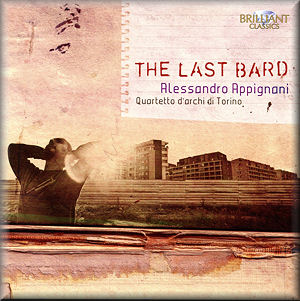| 

alternatively
CD: MDT
AmazonUK
AmazonUS
|
Alessandro APPIGNANI
(b.1970?)
Piano Quintet (2009} [11:45]
The Last Bard, for string quartet (2009} [4:55]
L'Aleph, 26 visions for piano (2009} [7:27]
Mediterranean Song - Canzona 1, for viola and piano (2009}
[2:29]
A Window in the Wood, for viola (2009} [9:03]
La Coscienza D'Orfeo, for violin, cello and piano
(2009} [1:56]
Hvareno, for string quartet (2009} [3:59]
The Green Island - Canzona 2, for cello and piano (2009}
[3:15]
Das Schloss, for cello (2009} [6:10]
Scuatù, for string quartet (2009} [2:29]
 Quartetto d’archi di Torino, Alessandro Appignani (piano), Yoko
Hanamaru (viola), Wolfgang Emanuel Schmidt (cello)
Quartetto d’archi di Torino, Alessandro Appignani (piano), Yoko
Hanamaru (viola), Wolfgang Emanuel Schmidt (cello)
rec. Gustav Mahler Hall, Dobbiaco, Bolzano, Italy, 22 July 2009,
11-12 Sept 2010, 23-24 Oct 2010, DDD
 BRILLIANT CLASSICS 9235 [53:34]
BRILLIANT CLASSICS 9235 [53:34]
|
Appignani’s music, for the most part, looks back to melody for
its vitality and ‘hook’.
In his two-movement Piano Quintet we experience a dark neurological
pool. The angel fall is a slow procession in which
the piano provides an tracery of downward-travelling note cells
over which the strings keen in a Zemlinskian melos. It’s intense
and oneiric. The second movement is in contrast. It’s a catchy
melange of Milhaud-Rio, wide-boy stride piano and Stravinsky
pianola cannonade. I am not sure it can be called a piano quintet.
It’s more like two movements for piano quintet.
The last bard is for string quartet. It’s popular,
optimistic and accessible as it ambles and trots along. Its
summer morning atmosphere is captivating. Do hear it. I think
you will enjoy its romantic Vivaldian buzz and dazzle.
L’Aleph deals in shades of Spiegel im spiegel.
It makes play with YHWH – the Yahweh (or Jehovah) signifier.
The Pärt reference is cut across with a piano current that gambols
along and cuts in. It’s attractive and rife with ideas that
appear and disappear rapidly. We are told that Appignani deploys
the ‘Fibonacci sequence’ and ‘cross-cabalistic numerology’.
If he does then I am not sure that this is crucial to the charm
of these 26 Visions.
The Mediterranean Song courses with smoothly rounded cantilena.
It’s full of sun-dappled music of an optimistic and faintly
jazzy disposition.
A window in the wood is a five movement suite for solo
viola. Eahc is etched with variety and character. Giddy dance
is a skittish and skittering moth-flight. Some of these short
movements are steeped in dissonance.
La Coscienza d'Orfeo for piano trio is short.
A fast piano pulse runs under cantilevered melodic material
bladed by string instruments. You will not be bored.
Hvarena is for string quartet. Its ambiguous shady
moods and melancholia is left behind in an irresistibly kinetic
ascent towards warmth and confidence.
The Green Island has a distantly recorded cello. It’s
a pleasing but not a complete experience. It is called Canzona
II and there is no doubt of its singing temperament.
Das schloss at first trades in Castle of Otranto
gothic goings-on – swooning reflection, beetling cliffs and
vertiginous battlements. It then finds its way to music that
is flowing, pattering and positive.
The disc closes with Scuatu. This is ambivalent, changeable
and sweet. Appignani finds an energy reminiscent of the Ravel
string quartet and melds this with singing popularity. It reminded
me of Michael Nyman’s Where the bee dances. Its dynamism
is welcome but the just ends in mid-air.
Not difficult music yet with sufficient substance to engage
and reward the listener prepared to try something modern and
out of the way.
Rob Barnett
|

